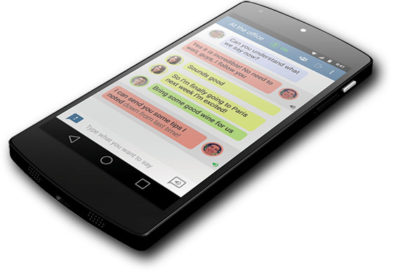Transcense
design team | Thibault Duchemin / Pieter Doevendans
360 million: The number of deaf and hard-of-hearing people worldwide

Thibault Duchemin
At SkyDeck’s Kairos Society startup competition in 2013, Thibault Duchemin, a graduate student in industrial engineering and operations research and the son of deaf parents, pitched an idea for a smart glove that could translate sign language into words on a screen. Pieter Doevendans, pursuing a master’s in innovation sciences at the Haas School of Business, joined Duchemin’s team because “Thibault wanted to solve a problem, unlike many ideas presented that weekend, which had no purpose.”

Transcense speech-recognition software on a smartphone. (Photos by Noah Berger)
At the end of the two-day competition, they presented their prototype, won Overall Best and launched a business. “We thought we knew what we had to build,” says Doevendans — until they interviewed a hundred potential users. “The hard-of-hearing all said the glove was not what they wanted. The real problem was following group discussions. That was a big moment for us. We pivoted.” Transcense was born when Duchemin and Doevendans recruited Skinner Cheng, a programmer who is deaf, to write the smartphone and web software.
Using the tool, individual speakers in a group conversation are recognized by their cellphones using existing speech recognition technology; in less than a second, the hard-of-hearing user’s phone displays a running text of the conversation, colored-coded to each speaker. Crowdsourcing response was dramatic; continuing research involves 50 beta users, and Transcense could be on the market within a year.

